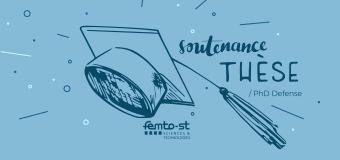You are here

Jérémy BON "Volume acoustic wave resonators trapped at very low temperatures:..."
Wednesday December 12th - 10h30Thesis works of Jérémy BON : "Volume acoustic wave resonators trapped at very low temperatures: Application to optomechanics"
Abstract : For several years, the FEMTO-ST Institute's Time-Frequency Department has been conducting a study on the behavior of trapped energy volume acoustic wave resonators in quartz crystals at cryogenic temperature, typically close to 4 K. The mechanical quality coefficient measured at these temperatures, several billion to a few tens of MHz, makes quartz acoustic cavities good candidates for ultra-stable cryogenic frequency sources.
The works presented in this manuscript are part of the continuity of this study program. They aim to consolidate the interest of quartz but also to consider alternative solutions based on materials with very low acoustic losses but not piezoelectric for which optical excitation is a credible alternative. The present works can be summarized in three major parts:
The first part was performed in order to determine a quartz section having an inversion point on its frequency-temperature characteristic at cryogenic temperatures. The only regulation of the resonator temperature of an ultrastable frequency source is indeed insufficient without the existence of such a point which must serve as an operating point for the thermal regulation. The search for a compensated cut required a preliminary campaign to measure the temperature coefficients of the elastic coefficients of the material, unknown at low temperatures. It was then possible, from the knowledge of these coefficients, to identify by calculation and then to make a cut fulfilling the desired conditions.
- The second part aims to prove the concept of using an optical cavity cavity made of quartz. In its basic version, the trapped volume wave quartz resonator is plano-convex (to ensure trapping) and electrodes (metal to ensure electrical excitation!) Deposited on each of its faces. It is demonstrated, theoretically and experimentally, that such a geometry functions in optical cavity, with its advantage of simplicity but with its limits. This basic structure must be used for the optomechanical coupling discussed in the third part and is the basis for designing more efficient optomechanical devices.
- The third part is devoted to evaluating the relevance of optomechanical coupling of such devices operating at cryogenic temperature. A study on the theoretical quantification of the optomechanical coupling that can reach such a cavity has been carried out.
Thesis Jury :
- M. BELLON Ludovic, Chargé de Recherche CNRS, ENS Lyon
- M. BONELLO Bernard, Directeur de Recherche, INSP
- M. COHADON Pierre-François, Maître de Conférence, ENS Paris, LKB
- M. CAGNOLI Gianpietro, Professeur, Université Claude Bernard, LMA Lyon
- M. DULMET Bernard, Professeur, ENSMM, FEMTO-ST
- M. GALLIOU Serge, Professeur, ENSMM, FEMTO-ST
- M. BOURQUIN Roger, Professeur retraité, ENSMM, FEMTO-ST
Location : Amphithéâtre Jules Haag -ENSMM - 26, Rue de l'Epitaphe - Besançon









